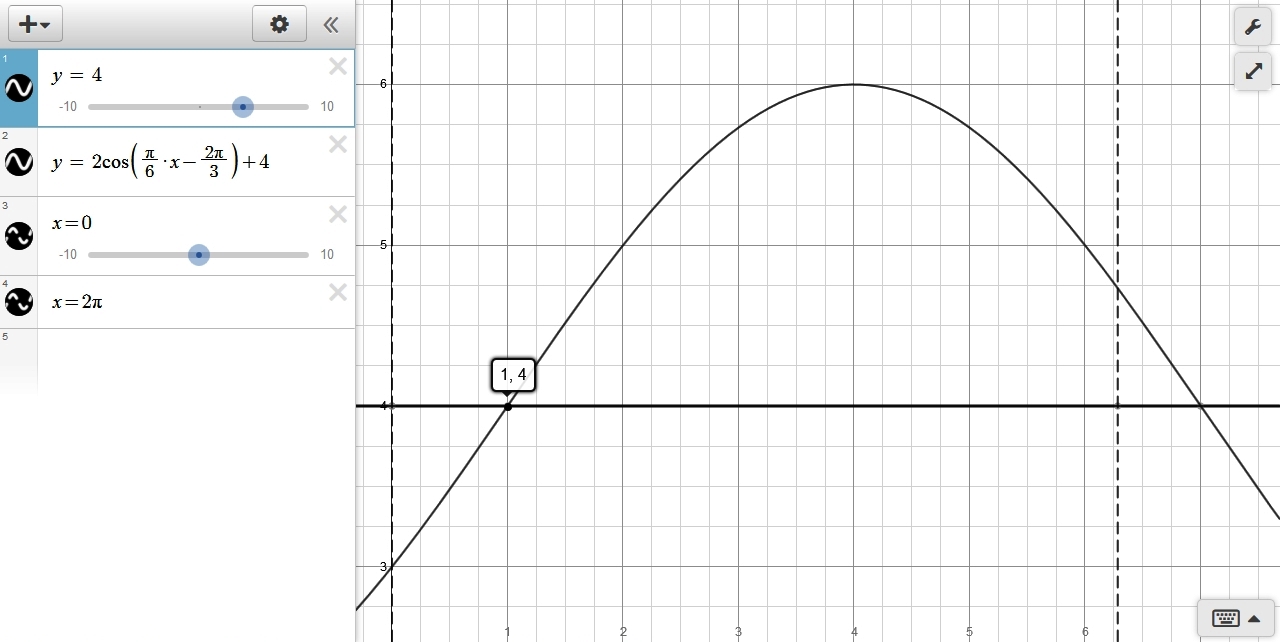subtract 4 from both sides of the equation to get:
0 = 2*cos(pi/6*x - 2*pi/3)
this is the same as:
2*cos(pi/6*x - 2*pi/3) = 0
since cos(pi/6*x - 2*pi/3) = cos(pi/6*x)*cos(2*pi/3) + sin(pi/6*x)*sin(2*pi/3), and since cos(2*pi/3) = -1/2 and since sin(2*pi/3) = sqrt(3)/2, then you have:
cos(pi/6*x - 2*pi/3) = cos(pi/6*x)*(-1/2) + sin(pi/6*x)*(sqrt(3)/2)
plug this back into your original equation of 2*cos(pi/6*x - 2*pi/3) = 0 and you get:
2*(cos(pi/6*x)*-(1/2) + sin(pi/6*x)*(sqrt(3)/2) = 0
simplify by distributing the multiplication to get:
-cos(pi/6*x) + sqrt(3)*sin(pi/6*x) = 0
add cos(pi/6*x) to both sides of this equaiton to get:
sqrt(3)*sin(pi/6*x) = cos(pi/6*x)
divide both sides of this equation by cos(pi/6*x) to get:
sqrt(3)*sin(pi/6*x) / cos(pi/6*x) = 1
divide both sides of this equation by sqrt(3) and you get:
sin(pi/6*x) / cos(pi/6*x) = 1/sqrt(3)
since sin/cos = tan, you get:
tan(pi/6*x) = 1/sqrt(3)
solve for pi/6*x to get pi/6*x = arctan(1/sqrt(3))
solve for x to get x = 6*arctan(1/sqrt(3))/pi to get x = 1
that's your solution.
x is equal to 1.
plug that back into your original equation to see if that's true.
4 = 2*cos(pi/6*x - 2*pi/3) + 4 becomes:
4 = 2*cos(pi/6 - 2pi/3) + 4
simplify this to get:
4 = 2*cos(-pi/2) + 4 which becomes:
4 = 0 + 4 which becomes 4 = 4
this confirms the solution is correct.
if you solved this graphically, you would graph:
y = 4 and y = 2*cos(pi/6*x - 2*pi/3) + 4
the intersection of the 2 equations would be your solution.
that graph is shown below:

to solve this equation you used the trigonometric identity of:
cos(a-b) = cos(a)*cos(b)+sin(a)*sin(b)
you also used the fact that 2pi/3 radians is equivalent to 120 degrees and cosine of 120 degrees is equivalent to minus cosine of 60 degrees which is equal to -1/2.
you also used the fact that 2pi/3 radians is equivalent to 120 degrees and sine of 120 degrees is equivalent to sin of 60 degrees which is equal to sqrt(3)/2.
120 degrees is in the second quadrant.
the reference angle for 120 degrees is 180 - 120 = 60 degrees.
that's the equivalent angle in the first quadrant.
in the second quadrant, sine is positive and cosine is negative.